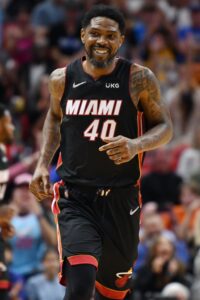Much has been made this offseason of the Lakers‘ ability to trade only their 2027 and 2029 first-round picks. That limitation is the result of two NBA restrictions related to draft-pick trades — the “Stepien” rule and the “seven-year” rule.
As we explain in our glossary entry, the Stepien rule prevents teams from leaving themselves without a first-round pick in two consecutive future drafts, while the seven-year rule prohibits teams from trading draft picks more than seven years in the future.
The Lakers traded their 2024 first-round pick to the Pelicans in the Anthony Davis blockbuster and gave New Orleans the option to defer that pick to 2025. Because New Orleans may receive that pick in ’24, the Stepien rule prohibits the Lakers from leaving themselves without a first-rounder in 2023. And because New Orleans may defer the pick to ’25, L.A. also can’t trade its ’26 first-rounder.
That leaves the Lakers’ 2027, 2028, and 2029 first-round picks as tradable — their picks in 2030 and beyond are currently off-limits because they’re eight or more drafts away. But moving the 2028 pick would render the ’27 and ’29 first-rounders unmovable due to the Stepien rule, which is why we haven’t heard that ’28 selection mentioned in any rumors this summer.
As the Lakers mull the possibility of attaching their 2027 first-round pick and/or their 2029 selection to Russell Westbrook‘s contract in order to acquire multiple rotation players, the potential protection on those first-rounders will be a major consideration.
NBA clubs are generally hesitant to move unprotected first-round picks, especially when they’re so far down the road — after all, it’s entirely possible that neither LeBron James nor Davis will be a Laker by 2027. Los Angeles will want to give itself some protection – even if it’s light protection – in the event that the club bottoms out and that ’27 pick ends up at No. 1.
However, pick protections become complicated when discussing draft assets that are five, six, or seven years down the road due to the seven-year rule. Not only can a team not trade a 2030 pick right now, but it also can’t push the protections on a pick beyond 2029.
As a reference point, let’s consider the first-round pick that the Pistons sent the Rockets in the Isaiah Stewart/Trevor Ariza/Christian Wood trade during the 2020 offseason. At the time of that deal, the protections on the Pistons’ traded first-rounder were as follows:
- 2021: Top-16 protected
- 2022: Top-16 protected
- 2023: Top-18 protected
- 2024: Top-18 protected
- 2025: Top-13 protected
- 2026: Top-11 protected
- 2027: Top-9 protected
The Pistons pushed the seven-year rule to the limit with that traded first-rounder, applying protections to all seven years in which the pick might change hands.
The selection, which has since been rerouted from Houston to Oklahoma City to New York, has yet to convey, but there’s a very good chance it will do so eventually, unless the Pistons’ rebuild really crashes and burns. If the first-rounder remains protected through 2027, the Knicks would instead receive the Pistons’ 2027 second-round pick, since Detroit wasn’t able to push the protections into 2028 due to the seven-year rule.
With that in mind, it’s worth considering what the Lakers can realistically do with protections on their 2027 and 2029 first-round picks.
Let’s suppose they want to put top-10 protection on their 2027 first-rounder, then push that first-rounder to 2028 if it lands in the top 10 in ’27. Due to the Stepien rule, taking that approach would jeopardize their ability to trade their 2029 pick, since they wouldn’t be able to trade both their 2028 and 2029 first-rounders.
To work around that issue, the Lakers might suggest leaving those top-10 protections on the 2027 pick and sending their trade partner second-round picks in 2027 and 2028 if the first-rounder lands in its protected range. That would leave the 2028 first-round pick untouched and would preserve L.A.’s ability to trade its 2029 first-rounder.
However, the Lakers’ trade partner would likely be reluctant to sign off on those terms, since that team would only have one shot at the 2027 first-round pick before it turns into a pair of far less valuable second-rounders. Any team discussing a deal with the Lakers would presumably push for that 2027 pick to be unprotected or extremely lightly protected in order to avoid that risk.
So let’s say the Lakers agree to make the 2027 pick unprotected. Could they then add protections to the 2029 pick instead? Well, due to the seven-year rule, there are even fewer options in establishing a backup plan for a protected 2029 first-rounder, since the Lakers wouldn’t have the ability to push that pick to 2030.
Realistically, if the Lakers wanted to add protections to their 2029 first-round pick, they could only agree to send their 2029 second-round pick in its place if the first-rounder landed in its protected range. That’s an even greater risk for a potential trade partner.
The ability to protect traded draft picks gives teams the ability to drastically influence the value of those traded picks. For example, if a lottery-bound team agrees to trade its 2023 first-round pick, but insists on adding top-20 protection and sending a 2026 second-round pick in its place if the first-rounder lands in its protected range, that’s not a very valuable trade asset. On the other hand, if that lottery team agrees to reduce the protections on that traded 2023 first-round pick for each year it doesn’t convey and eventually makes it unprotected, it suddenly becomes far more valuable as a trade chip.
Because the Lakers aren’t really able to take the latter approach with their 2027 and 2029 first-round picks at this point, it will be extremely difficult for them to add meaningful protections to those picks without significantly decreasing their value.
